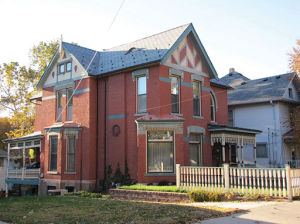150 Park Avenue – Thomas and Emma Cavin
Thomas E. Cavin came to Council Bluffs in 1866 and worked as a clerk in the dry goods store of Beno and Foreman, selling everyday products to the new settlers and those outfitting for settlement in the west. In 1871 he married Emma S. Field, the nineteen-year-old daughter of H.H. Field, a leader in the community and co-author of The History of Pottawattamie County. Thomas and Emma raised three children, Maud, Harry and George.
Shortly after his marriage, Thomas formed a partnership with Beno and Foreman to establish a store in Logan, Iowa, where the family lived until 1878 when the store was sold and they returned to Council Bluffs. He formed a partnership with Ira Scofield and they established the Scofield-Cavin Grocery Store at 218 Broadway. They sold goods to five other states and territories. Cavin continued in the retail business and in 1887, with assistance from his father-in-law H.H. Field he built his new home at 150 Park Avenue. The house was listed on the National Register of Historic Places in 1984.

In 1887, Thomas Cavin – with assistance from his father-in-law, H.H. Fields – built a home for his family at 150 Park Ave. The home was damaged by a fire in August 1934 and served as apartments from 1961 until 1990, but has since been restored to its original condition.
Cavin was associated with the John Beno Company for several years, then became floor manager- a position he held for fifteen years.
After Sarah Field’s death in 1894, H.H. moved in with the Cavins. Thomas Cavin died in 1911, and Emma continued to live in the house until 1919. She sold the house to Dr. John Stageman in 1920. During the depression the home also served as Dr. Stageman’s office.
In August of 1934, a fire started in the attic. Nearby houses (146 and 142) were also damaged. At that time, Dr. Stageman was still living there and renting rooms to four teachers. According to the National Register nomination, there was only a four-inch low-pressure water line on Park Avenue and the pressure quickly dropped as the firemen attached their hoses. The fire so affected the city that within two days the water board announced plans to install an eight-inch high-pressure line. The damage to the house was confined to the roof and attic.
The National Register nomination describes the house as eclectic styling with details and form reflecting influence from the Queen Anne and Gothic Revival styles. Notable details include the unusual decorative stucco and timber geometric pattern in the front gable end (dates from 1934), the tall rectangular windows with prominent hoodmolds, the rectangular and rounded bay windows with cottage windows having stained glass headers, and the highly decorative front porch with turned posts and elaborate frieze board. The Gothic influence is seen in the Gothic-arched window above the front porch, which has a stained glass header.
The fire resulted in the rebuilding of the roof on the same slope as the original, with the original eyebrow dormers duplicated on the new roof. The south chimney was removed and the new roof was built with a flat area on top while the original roof line was peaked. The front gable gingerbread was replaced by the herringbone stickwork after the fire. There were no changes in the interior room arrangement, the exterior brick structure or any of the porches because of the fire.
Through the years there have been several changes. The house was converted to apartments in 1961 and remained that way until 1990. The present owners have painstakingly restored the house to its original condition.
Source Material
Preserve Council Bluffs acknowledges the following sources of information for this series: National Register of Historic Places nominations, the reference department of the Council Bluffs Public Library, the auditor’s office of the Pottawattamie County courthouse, ancestry.com, and individual research. Much of the content of this article was taken primarily from the 1984 nomination to the National Register of Historic Places, prepared by Steve Barker.

Preserve Council Bluffs is a non-profit organization whose mission is to promote and preserve the heritage of Council Bluffs through its architecture, sites, and people.
© 2021 Preserve Council Bluffs | All Rights Reserved
Learn More
